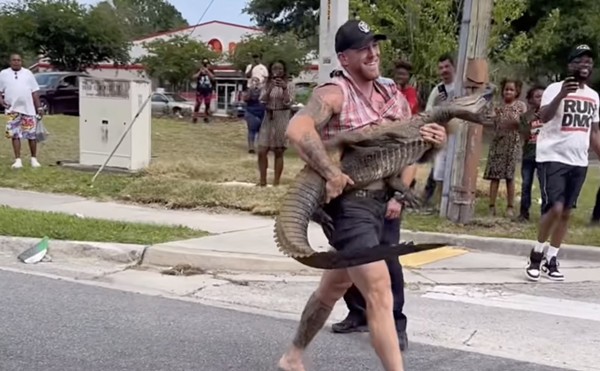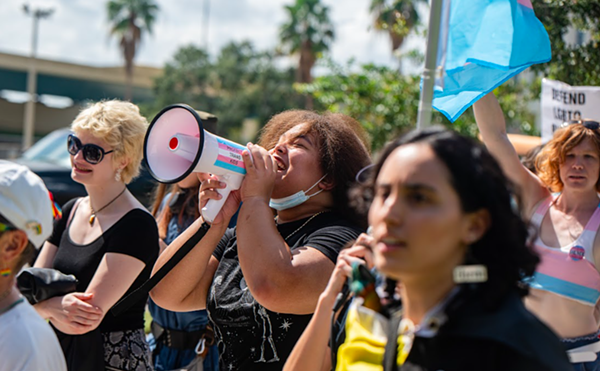My wife spent yesterday in New Orleans, getting the house ready to put on the market. She woke up at 5 a.m. to drive in with a friend. She cleaned the kids' rooms, hung the pictures back on the walls, stacked the Saturday, Aug. 28, issue of the Times-Picayune – the one with the "Katrina Takes Aim" headline – on the pile with the other papers.
I never asked about her trip. Finally, she brings it up. "You didn't say you appreciate my work," she tells me.
"You did that for yourself," I say. "I didn't even want you to go. Why should I thank you?"
"We have a house to sell."
"Nobody's thinking about curb appeal. Anyone who wants to buy that house is going to buy it anyway, even if it looks like shit. It doesn't matter. The rules are changed."
I keep on with this stubborn refusal. Right now, being angry feels like the right place for us.
Because I have a secret. All day, I've been carrying around the faxed contract from our real estate agents. It needs my signature to get things rolling. For two days, my wife kept reminding me to pick up the fax at a friend's office. I can't sign it.
Since the storm, our personal limbo has taken the form of two months in a 4-year-old's bedroom, a family of four sleeping in two twin beds pushed together. Our hosts' limbo is that their 4-year-old is back to sleeping with his parents until we're gone. So is their 2-year-old, whose room is now filled with the suitcases and clothes of two evacuated families.
Limbo ends next week. We're returning from our hosts' home in Carencro, La., to New Orleans for the remainder of the year. It's time for us to start reassembling.
But I'm not moving on, even if CNN has. If it's not about Katrina, I don't want to hear about it. Forget movies, forget TV, forget Scooter Libby. I'm still living in that week after the hurricane made landfall.
I keep thinking about how we watched the footage from the Superdome and sputtered at our president's disinterest in our drowning city. Why didn't we get a damn bus, load it with food and water and go save someone? Is this survivor's guilt? Or is it something we all should have been feeling a long time ago – the crush of poverty and despair that surrounded us?
Two days after my wife goes to New Orleans to clean our house, I also drive in. The real estate forms are stacked on the passenger's seat. I tell her I'll drop them off. But that's not why I'm going home. I want to get a haircut from my old barber. See some old friends. Eat at a New Orleans restaurant. I have to do something to get unstuck. So I try taking a pleasure trip.
DISASTER TOUR
Magazine Street is a series of shops and boutiques, interrupted by a few boarded homes. Taped-up refrigerators and piles of garbage line the sidewalks, but it's getting easier to overlook these scenes. A lot of the places are open. People are flocking here.
I start with late-afternoon bottles of Guinness at Aidan Gill's barbershop, where a "No Surrender" banner hangs over the front entrance. Supper at Taqueria Corona, which is filled with people I know. We greet each other with "How's your house?" That's the dividing line here: those who lost everything and those who didn't.
I am happy to see old friends. But I'm also growing tired of seeing everyone in different places, wearing different clothes, leading different lives. Even our faces look different.
A little farther up the street, a circle of Times-Picayune reporters are gathered on a front porch, swapping war stories. Ties are tucked into shirts, sleeves rolled up. I've made plans to join my friend, Tom Piazza, on Magazine Street. We join the reporters' gathering, then decide to head over to Mid-City. Tom wants to see his girlfriend's house. I want to see my old newspaper office. We're going to take a disaster tour.
On the drive down Canal Street, going away from the river, streetlights glow over a desolate thoroughfare. Then the lights stop. Crossing Claiborne Avenue is a plunge into darkness. It's like driving off a cliff.
Entering Mid-City, our headlights flash over the ruined cars, still covered in a crust of dried ash. Up ahead, a yellow, two-story root-beer mug towers before a restaurant, illuminated by a single floodlight. It's the only thing visible for blocks.
As we drive on, our headlights shine on piles of garbage that cast large shadows on houses and school buildings. "It's like being in a sick body," Tom says.
We turn to the side streets, tires rolling over debris. That's it. We get out.
The spell from Magazine Street has dissipated. When we arrive at my house, I pour canned water into two paper cups. We find a chess board among my daughter's toys. Tom is usually a little better at this game than I am. But now I'm playing the worst chess of my life. I only see one move at a time. I can't find any patterns.
We talk while we play. Tom tells me that he had to see me; over the phone, I was joking about the real estate prices. It had bothered him that I didn't seem to mind leaving. Now he knows better.
One game ends, we start up another. I move a rook into capture. Then a bishop. Tom builds his attack. We start up another game. I lose one after the other. It goes on like this for hours.
The next morning, I roll out of bed. I'm aware that I'm unshaven, wearing the same clothes from the night before, and I still have little cut hairs on my forehead from the haircut at Aidan Gill's.
It feels good to look a little crazy.
After breakfast, Tom and I go to a key store. We're getting keys made to my front door so he and his girlfriend can use my hot water. The cell phone rings. It's my wife. She immediately asks if I've talked to the real estate agents. I say I haven't even thought about it. I say good-bye and hang up.
Then I get another call. I look at the number – it's a 504 area code. Local. I answer.
"Hello?"
It's the real estate agent. And he knows I'm in town.
"How are you doing, guy?" he says.
I tell him I'm doing OK. That I'm at a key store.
"If you want," he says, "I can just come by the house and look it over."
That sounds good, I say. So in a few minutes, I meet him there. He pulls up on my street. Walks through my front door. Looks around the rooms with his real-estate-agent eyes. I like this guy. Just a little more than a year ago, he helped us buy this house. But now I want him gone.
"It looks good," he says.
We go upstairs, check the attic. No damage. I give him a key. He asks about the contract.
"I don't have it," I say.
"All we really need is that first sheet," he says.
"I'll fax it," I say.
He seems to hesitate. The last thing he'd heard, I was bringing the forms into town.
"OK," he says. I see him out.
When I start to think about staying in New Orleans, I can't stop. It's like an addiction. After losing her job as a pediatrician in the storm, my wife found a position in Chicago. It's the city where we met each other; it's a city we both like. So we have a plan. But now all I can think about is the escape hatch. Leaving doesn't seem real. What is our reason? She lost a job? So what? We can stay. We'll figure out something. Isn't this our home? Aren't we happy here?
These questions play through my mind on an endless loop.
I decide it's time to ask someone about stress – my stress and everybody's stress. So I contact Dr. Cheryll Bowers-Stephens. She's the assistant secretary for the Louisiana Office of Mental Health, and she's from New Orleans.
She tells me that 1.5 million people have been displaced. That we all have issues of loss. That we're all going through some level of grief reaction. It's the old Elisabeth Kubler-Ross road map for grief. Denial. Extreme sadness. Anger. "Then, as you enter the recovery stage, you start to accept what has happened," she says.
I'm nowhere near there yet. So I ask about those who don't accept. I think about an interview with New Orleans poet Kalamu ya Salaam that ran in the Oct. 3 issue of the New Yorker. "You are going to see a lot of suicides this winter," he said. "By winter, a lot of the generosity and aid that's been so palpable lately will begin to slow down and the reality of not going home again will hit people hard. They will be very alone."
How is this state going to handle the long term? Bowers-Stephens tells me about a crisis-counseling program called Louisiana Spirit. I ask her if it will be funded adequately. "We'll get something, but I don't know if we're going to get that much," she says. "New York City got close to $100 million after Sept. 11, but, of course, times are different."
She adds, "Plus, we were not meeting our target population prior to Katrina."
What does that mean?
"Prior to Hurricane Katrina, we were servicing about 3.6 percent of youth that were in need of mental health services, and about 28 percent of adults."
I ask if that means that nearly 97 percent of the kids who needed help weren't getting it.
"That's one way of saying it," she says. "I'd rather say what we were doing than what we weren't doing."
She talks about the need to educate policymakers on the importance of mental health. I tell her that I didn't lose my house, my family is fine, we have options and even I feel like I'm going crazy. So, yeah, I have to think it's going to get really bad for a lot of people.
I ask Bowers-Stephens if she's been asked to testify for the post-Katrina commissions that are being established by the governor and mayor. She says she turned over some reports but hasn't been asked to come in yet. "They're just beginning," she says. "They're going to tackle housing. I think they'll get around to mental health. I'm almost certain of it."
Before we hang up, I ask her one last question. It's the question that I can't get out of my mind. How can people get well when the sickness of their city – their country – has been so clearly exposed? Should New Orleanians even try to be sane when we all witnessed – no, participated in – an insane experience?
"If we wanted to find one enemy in all this, it would be poverty," Bowers-Stephens says. "And some focus on resolving that issue is going to be key to our recovery."
HEY JUDE
Walking through downtown, I pass the corner of Canal and Camp streets. Two demolished cars are resting on a brick sidewalk, surrounded by plastic orange fencing and yellow caution tape. The first one is a rental, a white Pontiac. The second one is a Land Rover. They're both blanketed in loose bricks. But instead of being hauled out, they've been relocated onto the sidewalk. They're starting to get buried in boxes and beer bottles. They're becoming part of the new cityscape.
If I'm going to wander around my New Orleans home, I at least need a destination. So I decide to stroll down to the French Quarter, to see if I can find a tourist. When I find one, I'll ask, "What are you doing here?"
I enter the French Quarter on Bourbon Street. When I first roamed around here, I was 15. I was with my cousin Fred. We'd driven in with my dad, who got sick and stayed in his hotel. Fred and I were suddenly unleashed on Bourbon Street. I heard live jazz for the first time, at Preservation Hall. On that same trip, a Category 1 hurricane hit the city. Fred and I dashed around the quarter, getting blown around by the wind.
The last time I visited the quarter I was with my kids. We were attending the grand opening of a new tourist exhibit that featured a simulated hurricane. You could stand inside a chamber and press the button. You'd stagger a little when the wind started up.
These days, "Hurricane Katrina Survivor" T-shirts are displayed in Bourbon Street shop windows. A few groups of young men walk by me. They're workers. I see some military guys. No tourists. I cross over to Jackson Square. I get a bag of beignets from Cafe du Monde.
In front of St. Louis Cathedral, I hear someone say, "Are you from New Orleans? Did your home flood?" A woman in jean shorts and a T-shirt takes a picture of a man who's covered in tattoos. He's from El Paso, and he found work repairing a downtown hotel. No, he doesn't know why the woman took his picture. I give him a beignet.
The Square is empty. Then several women pass by, carrying instant cameras.
"Are you tourists?" I ask.
No. They're a Kmart Emergency Response Team, sent here to help the Kmarts of New Orleans. They've been working 14 days straight. They have a half-day off.
"I wanted to bring them to see the nice things," says the district trainer from Orlando. She tells me she's a history buff. "When you come here," she says, "it's like visiting your ancestors."
I stop by Central Grocery to get a muffaletta – a classic New Orleans sandwich filled with sliced deli meats and olive salad. I've been craving one for two months. Central Grocery is still closed, but nearby, Frank's Restaurant is doing business. I get a half sandwich – two sliced quarters, wrapped in white paper.
Then, down on Decatur Street, I see a man in a red beret, sitting at a card table. He's Jude Acers, a street chess player who charges challengers $5 a game. The last time I saw Jude I brought my daughter to an exhibition match at a college in St. Bernard Parish. And here he is, at his regular table, facing off with some guy in a baseball cap and white beard.
"Is it OK if I eat my sandwich and watch?"
Jude regards me. "Did you get that at Central Grocery?" he asks.
"No, Central is closed. I got this at Frank's."
"So. Frank's is open. You've given us information. You've earned your place. Sit down."
Following Katrina, Jude was missing for days. Chess fans around the country were panicking. Then they learned that he had ridden out the storm and its aftermath for more than a week, helping to care for an old landlord. He finally landed in a 4-H camp in Tennessee. Then he returned to the city.
We watch Jude advance his pieces down the board. Olive salad spills from my sandwich, and I kick it to the gutter. The bearded man's wife comes by, and I give her a quarter of the sandwich.
I wish I could just stay here. It's cool and sunny, and it's the French Quarter. I've eaten beignets and a muffaletta, and Jude Acers is playing chess. As long as I'm here, the pieces are exactly where they are supposed to be. But I promised the kids I'd be home by bedtime. And there's one more stop I must make before leaving the city: the breach in the 17th Street levee. I have to see Hurricane Katrina's Ground Zero.
GROUND ZERO
Turning off I-10 on the Florida Boulevard/West End Boulevard exit, I crest the ramp and steer toward a giant, gray-brown mountain of debris, flecked with red and blue. Chair legs poke out from the top like little trees. Getting closer, I see that it's actually a range that continues on for blocks. A second mountain is all tree trunks and branches. On the next block is another debris mountain. Trucks keep pulling up with more trash. The piles change shape as new households are dumped in.
I pull up to a security guard and ask for directions to the levee breach. It's not an unusual question, he says.
I drive on dirty roads and finally pull over at the foot of the Old Hammond Highway Bridge. From there, I walk alongside the canal. I'm on an elevated path of fresh gravel. Looking down, I see a truck half-buried in the base of this path. A few giant white canvas sandbags, the size of bathtubs, are piled in a heap; "7,000 lbs." is stamped on the sides.
To my left, it looks as if a train had barreled through and smashed everything in its path. Even the brick houses have jagged holes in the walls. To my right is a calm strip of water.
A short wall runs along the path. Then it stops. A few hundred feet down, it resumes again. Here it is. Katrina was bad enough. It was strong enough to damage homes and kill people. But if this levee wall had held, I'd be back home now. I know I would.
It's just a few hundred feet. That's all. Enough to change everything. "Fuck you," I say under my breath.
A Louisiana State University team of researchers that examined documents obtained by the Times-Picayune concluded that the Army Corps of Engineers made a number of rookie mistakes. The levee wall was built on weak soil, and the sheet piling that supports the concrete wall didn't go deep enough into the ground. First-year engineering students would have known it would break. That's what you get for doing it on the cheap.
"Fuck you," I say again.
I'm moving my family out of this broken city. I don't want to, but I am. And I know it's what we need to do.
Fuck you.
I want to shout it. But there's an old couple here, walking around. So I walk over to them. We introduce ourselves.
"Why'd you come here?" I ask.
"We'd seen it on TV," says the woman, who moved to New Orleans from Honduras 25 years ago.
"We lived less than 10 minutes from here," says the man, who moved here from Chile three years ago, after he met the woman on the Internet.
"It's like a nightmare, and I can't wake up," the woman says.
"All the city is depressed at this moment," he says.
"They didn't want to spend their money," she says.
"All this could have been avoided," he says, waving his hand down at the gray wrecks.
"The first time I came back, there was no color anywhere," she says. "It was like a black-and-white movie. I was driving, and my legs were getting soft. I couldn't drive anymore. I had to stop. My body was like a puppet."
I ask if they're angry.
"Let's not even get to that," she says. "I wish I had a public microphone. I would tell it like it is."
They lost their home. They lost their jobs. They've been living in a shelter in Lafayette. They say they've learned about the goodness of people. Now they're back.
We stop talking for a while. The woman tells me that they drove to the French Quarter earlier today. They were looking for tourists, too. They didn't see any either.
"You know what we'd do sometimes?" she says. "Back before? We'd get some dinner ready; we'd put it in the basket. We'd drive to the lake. We'd talk, we'd joke. We'd go home again."
It's a good memory. "New Orleans has a soul," she says. That's why they're returning.
The sun is now setting over the canal. In the homes across the levee, where the wall didn't break, lights are turning on. A few blocks down, people are lining up for dinner at R&O Pizza Place.
I tell the couple good-bye. I ask them if they're glad they came to the levee breach.
"I think people need to see this," the woman says.
I don't make it home for the children's bedtime. When I walk into the dark room, everyone is piled in the twin beds. My wife wakes up.
"Maybe we shouldn't all move at once," she says. Maybe she should move up to Chicago early. Get started on her job. Find our new home. I can stay back with the kids and finish out our daughter's school year and keep writing here. Lots of families are doing it this way.
I realize that she's been thinking about this all day, ever since we talked on the cell phone. She's working on the next step. That's what she's been doing this whole time since the storm hit, working on the next step. And we – the four people in this little room – needed her to do that.
I sit down and move the sleeping body of my son toward the center of the beds. We'll talk in the morning.
Michael Tisserand was editor of Gambit Weekly, a New Orleans alternative newsweekly that resumed publication Nov. 1. He can be reached at [email protected].
[email protected]

















